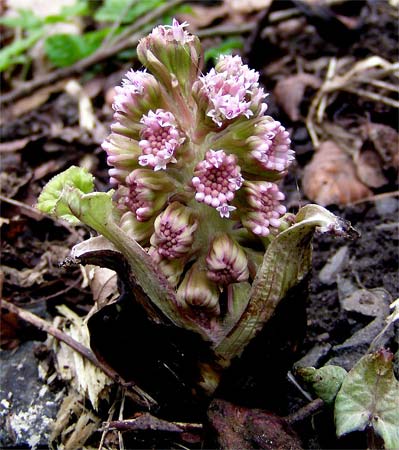- Petasites
Taxobox

image_width = 240px
image_caption = "Petasites hybridus" Butterbur
regnum =Plant ae
divisio = Magnoliophyta
classis =Magnoliopsida
ordo =Asterales
familia =Asteraceae
tribus =Senecioneae
genus = "Petasites"
genus_authority = L.
subdivision_ranks = species
subdivision = About 15-20 species; see textThe
plant s commonly referred to as Butterbur are found in thedaisy familyAsteraceae in thegenus "Petasites". They are mostly quite robust plants with thick, creeping undergroundrhizome s and largeRhubarb -like leaves during the growing season. Another common name for many species of this genus is Sweet Coltsfoot.The short spikes of
flower s are produced just before the leaves in spring, emerging with only a few elongated basal bracts and are usually green, flesh coloured or dull white depending on species.Butterburs are found in the temperate zone of the Northern Hemisphere. They prefer moist environments such as riverbanks, marshes and ditches.
"Petasites" is very closely related to the genus "Tussilago" (Coltsfoot), and also related to the huge genus "
Senecio ".Medicinal uses
Butterbur was used by native Americans as a remedy for headache and inflammation. Some Butterbur contains
petasin [http://pubchem.ncbi.nlm.nih.gov/summary/summary.cgi?cid=5320502] andisopetasin , with the highest concentrations occurring in the root. The best-documented beneficial effect of Butterburextract s are as a treatment ofmigraine headaches. [http://www.butterburherb.com/en/science_and_research.php] Several mainstream double-blind studies have shown that extracts of Butterbur petasin and/or isopetasin are effective both in preventing and in relieving migraine, with the best results coming in more severe cases [Lipton, R.B. et al. (2004) [http://www.ncbi.nlm.nih.gov/entrez/query.fcgi?cmd=Retrieve&db=pubmed&dopt=Abstract&list_uids=15623680&query_hl=3 Petasites hybridus root (butterbur) is an effective preventive treatment for migraine.] Neurology 63(12):2240-4 Retrieved on 2007-04-30] . Additionally, a peer-reviewed journal published a Swiss study showing Butterbur extract to be an effective treatment for hay fever without the sedative effect of the antihistaminecetirizine [Schapowal, A. (2002) [http://www.bmj.com/cgi/content/full/324/7330/144 Randomised controlled trial of butterbur and cetirizine for treating seasonal allergic rhinitis] Br Med J. 324:144-146 Retrieved on 2007-04-30] .Butterbur naturally contains components called
pyrrolizidine alkaloid s. They are toxic to the liver and may cause cancers. The concentrations are often highest in the rhizomes and stalks and lowest in the leaves and may vary depending on where the plants are grown. Butterbur extract should be taken only when prepared by a reputable laboratory. Long-term health effects and interaction with other drugs have not been studied.elected species
*"
Petasites albus " White Butterbur
*"Petasites amplus "
*"Petasites doerfleri "
*"Petasites formosanus "
*"Petasites fragrans " Winter Heliotrope
*"Petasites frigidus " (syn. "P. speciosa") Arctic Butterbur or Arctic Sweet Coltsfoot
*"Petasites hybridus " Common Butterbur
*"Petasites japonicus " Giant Butterbur, or Fuki
*"Petasites kablikianus "
*"Petasites paradoxus "
*"Petasites radiatus "
*"Petasites sagittatus "
*"Petasites sibiricus "
*"Petasites speciosa "
*"Petasites spurius "
*"Petasites tatewakianus "
*"Petasites tricholobus "Hybrids
*"Petasites x vitifolius"
In popular culture
In the
manga "Shaman King ", the young Ainushaman Horohoro dreams of planting a vast field of Butterbur from the east to the west coast ofHokkaidō .References
External links
* [http://rbg-web2.rbge.org.uk/cgi-bin/nph-readbtree.pl/feout?FAMILY_XREF=&GENUS_XREF=Petasites&SPECIES_XREF=&TAXON_NAME_XREF=&RANK= Flora Europaea: "Petasites" species list and distributions]
* [http://www.efloras.org/browse.aspx?flora_id=0&name_str=Petasites eFloras search results: "Petasites"]
* [http://www.butterbur.com/ www.butterbur.com] (Link Broken)
Wikimedia Foundation. 2010.
